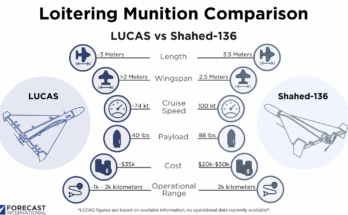
So far this year, four defense committees in Congress have put their own unique spin on the FY23 defense budget while taking the administration’s request and other funding recommendations into account. In this post, we’ll use data from Forecast International’s U.S. Defense Budget Forecast database to examine how the legislative markups might impact Pentagon acquisition programs.

What Changes Have Been Made to Procurement and RDT&E Funding?
For FY23, The House Armed Services Committee (HASC) and the Senate Armed Services Committee (SASC) recommended a total of $300.9 billion and $297.5 billion, respectively, for procurement and research, development, test, and evaluation (RDT&E) programs in their defense authorization bills. These recommendations exceed the president’s request of $276 billion for all acquisition programs. For the House committee, that would mean an extra $16.3 billion for procurement and $8.6 billion for RDT&E. For the Senate committee, the recommendations would equal $13.8 billion more for procurement and $7.7 billion for RDT&E.
For the House Appropriations Committee (HAC) and Senate Appropriations Committee (SAC), the situation is more uncertain. The HAC’s version of the defense appropriations bill is roughly in line with the President’s request, although the procurement account drops by nearly $1 billion, while $1.6 billion is added for RDT&E. The SAC’s version pushes for an $11.9 billion budget increase for procurement and an extra $4.5 billion for RDT&E. The vast differences between each committee’s defense spending bill will be negotiated as part of a final conferenced appropriations bill. Given the overall support in Congress for higher levels of defense spending, the lower numbers in the HAC bill will likely be modified upward.

Impact on Procurement Accounts
So, which procurement budgets will be the most affected by these defense budget changes?
- The Navy’s shipbuilding account. The HASC and SAC each recommend adding over $4 billion for Navy shipbuilding, while the SASC would add a more moderate $1.4 billion. On the other side of the coin, the HAC cut shipbuilding funding by $137.4 million. If additional funding materializes in the final defense spending bill, it could be used for additional DDG 51 destroyer, support for amphibious warships like the LPD Flight II and America class LHA, extra LCAC 100 Ship-to-Shore Connectors, or an additional T-AO 205 class oiler.
- The Navy’s aircraft account. The HASC wants to add $3 billion for Navy aircraft, which is the largest increase of all the defense committee bills, thanks to the addition of eight F/A-18E/F Super Hornets. The SAC suggested adding $1.2 billion for aircraft, while the HAC would cut $513 million, resulting in the loss of two MQ-25 unmanned tankers.
- The Air Force’s aircraft account. The SASC added $3.1 billion for extra F-35s, HH-60Ws, and EC-37B Compass Call aircraft. The SAC recommended a $2.2 billion increase, of which $1.7 billion is for 16 C-130Js for the Air National Guard, and the rest would bolster the HH-60W and EC-37B. Conversely, the HAC suggested cutting six F-15EX fighters from the defense bill.
- The Army’s weapons and vehicles account has committees split. The SAC would add $1.2 billion, including extra funding for Armored Multi-Purpose Vehicles, Abrams tank upgrades, and Stryker upgrades. The HASC bolstered each of those programs as well, but the other committees were less supportive. Three committees also suggested an increase for the Army’s Paladin howitzer, but the SAC left that program unchanged.

Impact on Research and Development Budgets
How will this new budget outlook affect RDT&E budgets?
- The Army stands to come out ahead regardless of how negotiations unfold, as each committee recommended an increase for the service. Both the HAC and SAC want to add funding for various applied research and advanced technology development efforts for the Army, including ground systems and combat vehicles.
- Navy research and development funding would increase by over $1 billion in both defense authorization bills and the HAC bill, but the SAC recommends a more modest $366.7 million increase.
- For the Air Force, both armed services committees aimed to increase funding, but the HAC and SAC reduced funding by $960.4 million and $417.3 million, respectively. The HAC bill includes a $110 million cut to the B-21 bomber, $95 million to the Air Force One replacement program, and $86.5 million to the Ground Based Strategic Deterrent. The SAC bill includes similar reductions for the B-21 and Air Force One, as well as cuts to the Air Force’s tech transition program, software pilot programs, and the Survivable Airborne Operations Center.
- Research funding for Defense-Wide agencies grows by as much as $4.5 billion in the HASC bill, or as little as $521.6 million in the HAC bill. The former includes an extra $1 billion for the Defense-Wide Manufacturing Science and Technology program, $360 million for the technology innovation program, and $317.5 million for hypersonic defense, among other items.
Want to Learn More About Congressional Markups or the Pentagon’s Annual Budget Requests?
Forecast International’s U.S. Defense Budget Forecast is a streamlined database providing fast and easy access to the Pentagon’s entire acquisition budget. The product features sorting and data visualization options, and presents the entire FYDP through an online interface with downloadable Excel spreadsheets. This is the go-to service for anyone familiar with the grind of wading through the massive DoD budget.
Shaun's deep-rooted interest in military equipment continues in his role as a senior defense analyst with a focus on the United States. He played an integral role in the development of Forecast International's U.S. Defense Budget Forecast, an interactive online product that tracks Pentagon acquisition programs throughout the congressional budget process. As editor of International Military Markets – North America, Shaun has cultivated a deep understanding of the vast defense markets in the United States and Canada. He is a regular contributor to Forecast International's Defense & Security Monitor blog and has co-authored white papers on global defense spending and various military programs.




